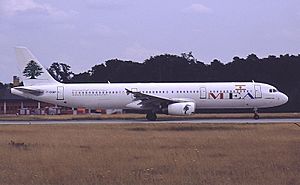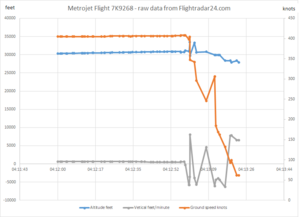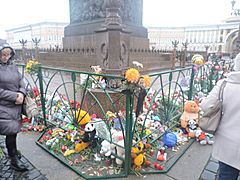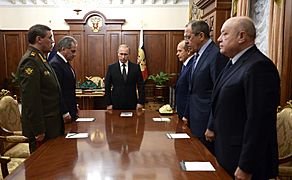Metrojet Flight 9268 facts for kids
| Bombing summary | |
|---|---|
| Date | 31 October 2015 |
| Summary | Terrorist bombing by Islamic State's Sinai Branch |
| Place | Near Housna, North Sinai Governorate, Egypt 30°10′9″N 34°10′22″E / 30.16917°N 34.17278°E |
| Passengers | 217 |
| Crew | 7 |
| Fatalities | 224 |
| Survivors | 0 |
| Aircraft type | Airbus A321-231 |
| Airline/user | Kogalymavia (Metrojet) |
| Registration | EI-ETJ |
| Flew from | Sharm El Sheikh International Airport, Sinai Peninsula, Egypt |
| Flying to | Pulkovo Airport, Saint Petersburg, Russia |
Metrojet Flight 9268 was a passenger plane trip. It was operated by a Russian airline called Metrojet. On October 31, 2015, the plane exploded over the northern Sinai Peninsula in Egypt. It had just left Sharm El Sheikh International Airport. The plane was on its way to Saint Petersburg, Russia.
All 224 people on board died. This included 217 passengers and 7 crew members. Most people believe a bomb on the plane caused the crash. Russian investigators confirmed this.
Most of the people on the flight were tourists. There were 212 Russians, four Ukrainians, and one Belarusian. All seven crew members were Russian. Investigators think a bomb was placed on the plane in Sharm El Sheikh. The goal was to make airlines stop flying to that airport.
Soon after the crash, a group called the Islamic State's Sinai Branch said they were responsible. This group is also known as Ansar Bait al-Maqdis. They claimed responsibility on social media and in a statement. They even showed pictures of what they said was the bomb.
By November 4, 2015, British and American officials thought a bomb caused the crash. On November 8, an Egyptian investigator said they were "90 percent sure" it was a bomb. On November 17, Russia's security service said it was a terrorist attack. They found traces of explosives. On February 24, 2016, the President of Egypt, Abdel Fattah el-Sisi, agreed that terrorism caused the crash.
Contents
About the Aircraft
The plane was an Airbus A321-231. It was 18 years old. It first flew on May 9, 1997. It was used by several airlines over the years. In 2012, Metrojet started using it.
In 2001, the plane had a problem called a tailstrike. This happens when the tail of the plane hits the runway during landing. This happened in Cairo, Egypt. No one was hurt, but the plane was badly damaged. It was repaired within three months and went back to flying.
At the time of the crash, the plane had flown about 56,000 hours. It had completed nearly 21,000 flights.
Passengers and Crew
| People on board by nationality | |||
|---|---|---|---|
| Nationality | Passengers | Crew | Total |
| 212 | 7 | 219 | |
| 4 | 0 | 4 | |
| 1 | 0 | 1 | |
| Total | 217 | 7 | 224 |
Flight 9268 had 217 passengers and seven crew members. Twenty-five of the passengers were children. The pilot was Valery Yurievich Nemov, aged 47. The co-pilot was Sergei Stanislavovich Trukhachev.
Captain Nemov had flown for over 12,000 hours. About 3,800 of those hours were on this type of plane. Co-pilot Trukhachev had flown for 5,641 hours. Over 1,300 hours were on this plane type.
Most passengers and all crew were Russian. There were also one Belarusian and four Ukrainian passengers. Many passengers were tourists returning from Red Sea resorts. Many children were left without parents because of the crash.
The Crash Event
Flight 9268 took off from Sharm El Sheikh airport at 5:50 AM local time. It was heading to Pulkovo Airport in Russia. Twenty-three minutes later, the plane stopped contacting air traffic control.
The Islamic State's Sinai branch quickly said they brought down the plane. Russian news first claimed the pilot reported problems. They said he asked to land at the nearest airport. But later checks of the flight recorders showed this was not true.
The plane was flying at about 31,000 feet (9,400 meters). Then, it suddenly dropped 5,000 feet (1,500 meters) in one minute. It then disappeared from radar. Data showed the plane climbed to 33,500 feet (10,200 meters). Then it quickly dropped to 28,375 feet (8,649 meters). This happened about 50 kilometers (31 miles) northeast of Nekhel.
A bomb exploded inside the plane. This caused the plane to break apart in the air. All 224 people on board died.
The plane's wreckage was spread over a large area. This showed that the plane broke up high in the sky. The front part was about 5 kilometers (3 miles) from the tail. This suggested the tail separated during the flight.
Investigation into the Crash
Ayman al-Muqaddam led the investigation in Egypt. At first, some thought the pilot asked to land. But air traffic control recordings showed no such calls. The President of Egypt, Abdel Fattah el-Sisi, said the investigation would take months.
Russia sent planes and investigators to help. They also questioned airline staff. France, Germany, and Ireland also sent experts. These countries were involved because of the plane's design, making, and registration.
Both the flight data recorder and the cockpit voice recorder were found. These "black boxes" record what happens on the plane. The cockpit voice recorder was partly damaged. But it showed that everything was normal until a sudden, loud noise. This noise was heard just before the recording stopped. This suggests an explosion.
A US satellite detected a heat flash at the time of the crash. This could mean an explosion happened on the plane. It ruled out a missile attack from outside. British and American officials soon suspected a bomb. British intelligence found communications between militants in Sinai. These suggested a bomb was put in the plane's cargo area.
The UK stopped flights to and from Sharm El Sheikh. This left many British tourists stuck. British officials went to Egypt to check airport security. They showed they did not trust Egypt's security measures. Experts said it was unlikely the plane was hit from outside. Terrorist groups in Sinai did not have missiles that could reach a plane at 30,000 feet (9,100 meters).
On November 17, 2015, Russia said it was a terrorist attack. They found traces of explosives in the wreckage. They said a homemade bomb, like one with up to 1 kilogram (2.2 pounds) of TNT, caused the crash. Russia offered a $50 million reward for information. Some airport workers were questioned about placing the bomb. Egyptian authorities denied any arrests.
In November 2015, the Islamic State published pictures of what they claimed was the bomb. It showed a soda can with explosives, a detonator, and a switch. Russia's Defense Minister also said the Sinai branch of ISIL was responsible.
In December 2015, Egypt's investigation committee said they found "no evidence that there is an act of terror." Russia disagreed, saying their experts confirmed it was a terrorist attack.
In January 2016, a mechanic was suspected of planting the bomb. He was believed to have been given it by his cousin, an IS member. Two policemen and a baggage handler were also suspected of helping.
Finally, on February 24, 2016, Egyptian President Abdel Fattah el-Sisi admitted that terrorism caused the crash. He said the goal was to hurt tourism and relations with Russia.
Other Ideas About the Crash
Some people wondered if the plane had a mechanical problem. The co-pilot's ex-wife said he had complained about the plane's condition.
The plane had a "tailstrike" in 2001. This is when the tail hits the runway during landing. Some compared it to another crash, Japan Airlines Flight 123. That plane crashed after a bad repair from a tailstrike. This made its rear part weak. Reports on Flight 9268's wreckage suggested a break near the plane's rear. This could mean a weakness there.
Metrojet said the plane was safe to fly. They said the tailstrike damage was fixed. They also said the engines were checked just five days before the crash.
Some thought a missile might have hit the plane. But this was seen as unlikely. Terrorist groups in Sinai did not have weapons that could reach a plane at high altitude. Russian officials also said there was no evidence of a missile attack. The flight recorders showed the plane was not hit from outside.
Changes to Air Travel
After the crash, many airlines changed their routes. Emirates, Lufthansa, and Air France–KLM avoided flying over the Sinai Peninsula. The US Federal Aviation Administration had already told US airlines to fly above 26,000 feet (7,900 meters) over Sinai.
On November 4, the British government advised against all but essential air travel to Sharm El Sheikh. All British flights to the resort were canceled. Ireland also stopped its airlines from flying to or over Sinai.
On November 5, Air France-KLM did not allow checked bags on a flight from Cairo. More than half the passengers refused to fly. About 20,000 British tourists were stuck in Sharm El Sheikh. Flights to the UK were allowed from November 6. But passengers could only take hand luggage. Checked bags would be sent later after more security checks.
On November 6, Russian President Vladimir Putin canceled all Russian flights to and from Egypt. Many British airlines sent planes to bring tourists home. But Egyptian authorities limited flights due to airport crowding.
By November 8, about 11,000 Russian and 5,300 British tourists had returned home. By November 9, British airlines canceled flights to the resort until at least November 25. Airport security around the Middle East was expected to get much stricter.
Aftermath of the Crash
In March 2016, Metrojet airline went out of business. This was because of the bombing and safety concerns in Egypt. Fewer people wanted to fly with them.
In April 2018, Aeroflot and EgyptAir started flights between Moscow and Cairo again. Flights between Russia and other Egyptian places restarted in August 2021.
Airports worldwide made security checks for staff much stricter. About 70 airport workers in Paris lost their security clearance. This was due to suspected links to extremist groups.
International Reactions
Russia
On November 1, 2015, Russia stopped all Metrojet A321 planes from flying. The Russian transport group asked Metrojet to stop using these planes. This was until the crash cause was found.
Russia's Foreign Ministry said their embassy was following the events. President Putin declared November 1 a national day of mourning in Russia. This is a day for people to remember those who died.
At first, Russian officials said there was no proof of a terrorist attack. They denied any link to Russia's actions in Syria. But on November 17, Russia's security chief said it was a terror attack. The Russian government offered a $50 million reward for information.
-
People placing flowers and toys in Palace Square, Saint Petersburg, on November 4, 2015.
-
Russian President Vladimir Putin at a meeting about the crash investigation.
Egypt
Hours after the crash, Egyptian Prime Minister Sherif Ismail went to the crash site. Other ministers joined him.
Ireland
Ireland offered to help with the investigation. This was because the plane was registered there. The Irish Air Accident Investigation Unit sent a team of experts. They flew to Egypt on November 2.
Israel
Israel, which is next to the Sinai Peninsula, offered to help Russia and Egypt. They offered to help with surveillance if needed.
Ukraine
In April 2018, Ukraine's foreign minister, Pavlo Klimkin, talked about the bombing. After the travel ban was lifted, Ukraine International Airlines started direct flights between Kyiv and Cairo.
United Kingdom
On November 4, British intelligence agencies joined the investigation. The UK government sent extra staff and military planners to Egypt. Egyptian President al-Sisi met British Prime Minister Cameron in London. They talked about improving security at Sharm El Sheikh airport.
Less than a week after the crash, the UK banned flights to Sharm El-Sheikh airport. This ban lasted until October 2019. The UK government also advised against most travel to South Sinai.
United States
US President Barack Obama said on November 5 that the US was taking the incident seriously. They knew there was a chance a bomb was on board.
See also
 In Spanish: Vuelo 9268 de Metrojet para niños
In Spanish: Vuelo 9268 de Metrojet para niños
- Accidents and incidents involving the Airbus A320 family
- List of accidents and incidents involving commercial aircraft
- Timeline of airliner bombing attacks







